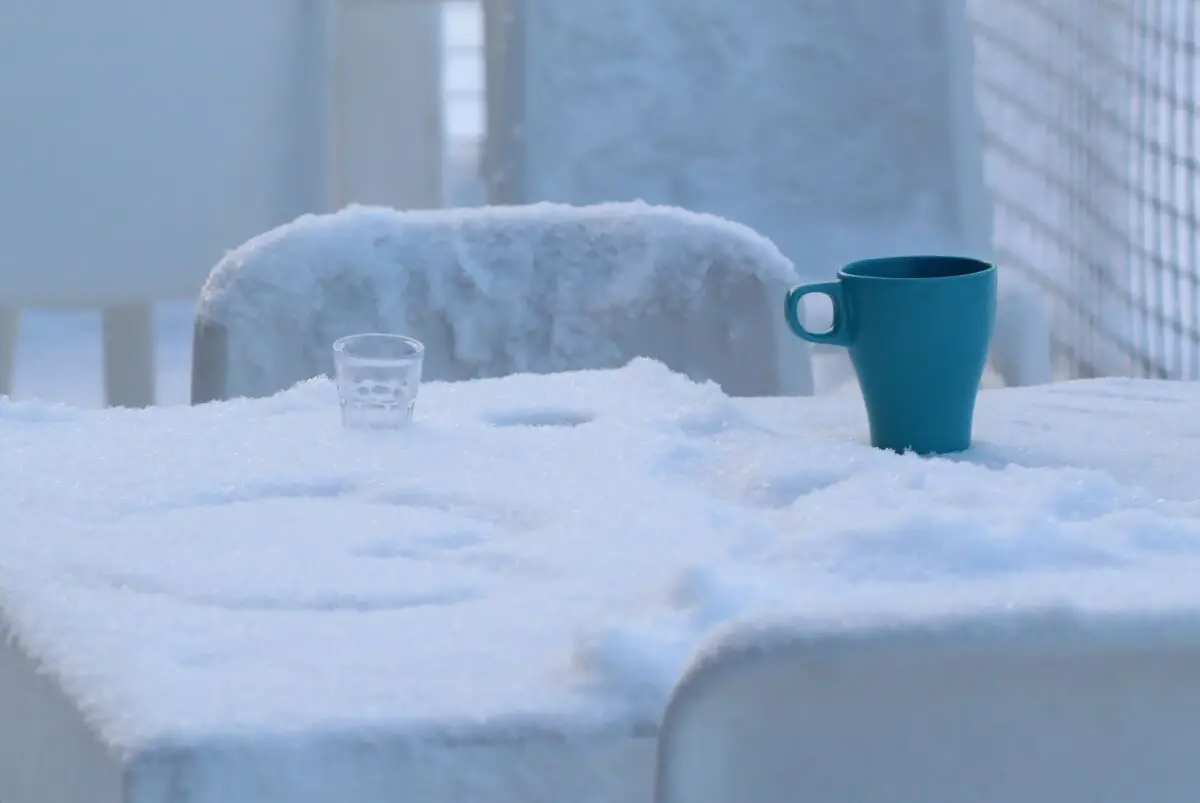Winter can be brutal for porches and balconies. Whether you’re trying to save your plants or relax outside without freezing, there are several reasons to protect your home (inside and out). The good news is that it’s relatively straightforward to cover your balcony during any time of the year.
To enclose a balcony for winter, check with your landlord, measure the balcony’s frame, choose a weatherproof material, and seal it with tape. Ensure that there aren’t gaps at the top or base of the balcony, then create vents for optimal airflow. Cover the furniture to prevent rust and condensation.
Throughout this article, you’ll also discover the following details about enclosing a balcony for winter:
- Detailed step-by-step instructions for the best results
- Additional safety and comfort tips you can use for winter and autumn
- How to choose the best materials and tools for the job
1. Check With Your Landlord or Leasing Company
If you’re living in a rental property such as an apartment or condominium, there’s a chance that there are some restrictions for what you can or can’t do with your balcony. Some housing agencies are really strict about what you can put on your balcony and what kind of activities you’re allowed to do—especially if you alter the property in any kind of way.
Before starting your winter balcony DIY, take a look over your housing contract and talk with your leasing company to make sure everything is okay.
Let them know about the following steps you’d like to take to enclose your balcony to keep it warm during winter and get the leasing company’s approval.
If they say yes, then wonderful! You’re ready to get started with the DIY project! However, if your landlord or leasing company rejects your idea, fret not. There are other ways you can go about staying warm on a balcony.
Once you have approval, it’s time to gather all of the information and supplies you’ll need to complete the DIY.
2. Measure the Frame of the Balcony
Let’s start the balcony enclosure DIY off by measuring the size of your balcony. This is an essential step because it’ll determine how much of the materials you’ll need to buy and what size you’ll cut them.
Practice safety while measuring your balcony, and avoid hanging over the railing or standing on anything that’ll make you taller.
For this step, all you’ll need is:
- a tape measure
- paper
- a pencil
A retractable tape measure with a self-locking blade works best because it’ll allow you to extend it up to the ceiling of your balcony without the use of a ladder or stepping stool.
- Take the measuring tape and start at the base of the balcony in one of the corners along the apartment wall. Extend the measuring tape blade up the wall until it reaches the top of the ceiling. Try to keep it as straight as possible.
- Take note of the height of the balcony and jot it down with your paper and pencil.
- Next, you’ll need to know the depth of your balcony. From the same corner as before, run the measuring tape’s blade from the corner that is along the wall of your home to the corner across from it that is the edge of the balcony.
- Lastly, you’ll need to measure the length of your balcony. Simply measure from one outside edge of the balcony to the other.
The reason you’ll want the measurements for the inner side of the balcony instead of the outer side is that if there’s ever a big storm that causes the enclosure to tear or fall, it’s better for it to land on the balcony instead of falling off it.
3. Choose the Enclosing Materials
According to Captain Patio, there are four materials that you could choose to enclose your balcony:
- Heavy-duty plastic
- Waterproof curtains
- Plexiglass
- Clear PVC tarps
The first option is cheap and readily available, but you’ll have to replace it annually. That’s not much of an issue if you’re okay with resealing it every autumn and pulling it down every spring.
Waterproof curtains are an excellent choice for rainy climates, but they’re not the best for snow. If you live in a rainy area, you’ll find them more than worth the investment, though.
Plexiglass is a fantastic option, but it’s quite expensive. It’s also one of the most durable options on the list, so the trade-off is worth it for many people.
Finally, clear PVC tarps can be used for rain or snow. Keep in mind that PVC corrodes from excess sunlight. It’s quite heavy and durable, so why not give it a try?
4. Cut the Material to the Proper Length
When you’ve chosen the previously mentioned materials, cut them to size. You’ll have to use the measurements you got earlier in the article. Cut them a few inches longer in every direction so you can tuck it underneath. We’ll discuss the tucking method more in a few subheadings.
Another reason you should cut it a bit longer is to prevent errors. You don’t want to go back to the store or place another order online if you cut it too short. You’ll have to hang the material at least a few inches over the balcony cover, too.
5. Seal It With Heavy-Duty Tape
In another article, we wrote about how weatherproof tape resists rain, sunshine, and snow. Use it to connect the three or four sheets you’ve created above. It would be best if you sealed it along the lines, overlapping the material by one to two inches on all sides.
Remember to use heavy-duty tape to attach or hang the material from the top. It’ll drape down, putting a lot of pressure on the tape. It’s recommended to layer the tape two or three times on top.
6. Cover the Bottom Sections
If it’s windy where you live, seal the bottom sections of each material cutout with more tape. Press the tape against the balcony to seal it. You’ll notice that it limits airflow and proper ventilation, which is why the next section is crucial. Too much tape and sealant will make it foggy and humid on the balcony.
7. Create Ventilation Areas
If you sealed the bottom area, leave a six-inch section for every foot of tape. It’ll allow air to flow through the underside without blowing everything around. You won’t have to worry about rain or snow since the gaps are too small.
If there’s not enough ventilation, it’ll start to leak condensation. Your furniture will rust, the ground will get wet, and the air will feel gross and humid.
8. Consider Covering All Furniture
If you have furniture on the balcony, cover it when you’re not using it. Condensation causes rust, which corrodes your furniture.
You can use blankets, but outdoor tarps (such as the aforementioned PVC tarps) are durable and long-lasting enough to protect your furniture and other outdoor belongings.
Conclusion
Enclosing a balcony is relatively easy once you have the proper materials. If you can cut and tape materials, you have all of the experience you need. This quick repair can protect your balcony and furniture for many years to come.
Here’s a rundown of what the post should’ve taught you:
- Heavy materials won’t rip or blow around in the wind.
- Make sure you use a weatherproof sealant to keep snow and rain out.
- Don’t forget to make vents to prevent condensation and humidity.
- Enclosing a balcony can increase your home’s value by limiting seasonal damages.

